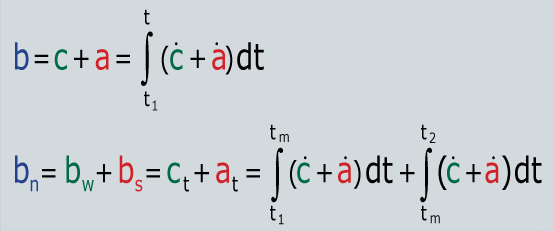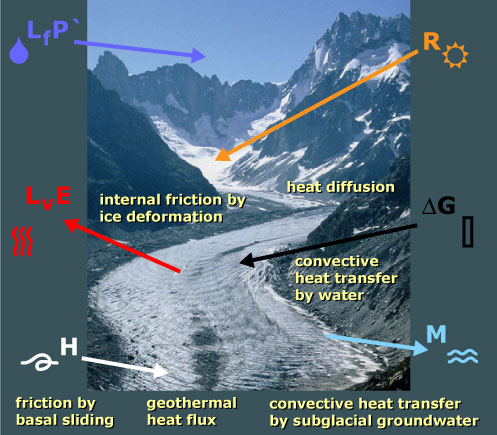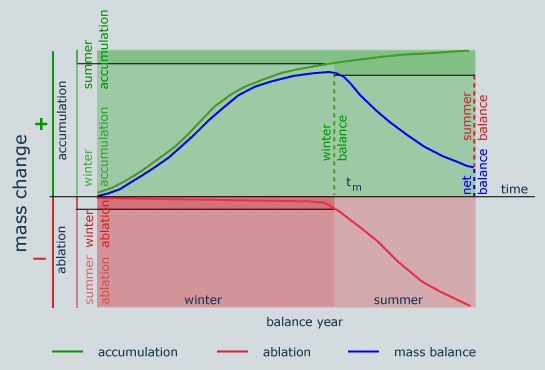 |
|
|
|
|
|
|
Changes in mass, temperature and water content of glaciers are determined by the energy fluxes through the interface between glacier and atmosphere and in the glacier body itself. Mass changes are mainly dominated by the energy exchange between atmosphere and glacier surface. Energy fluxes
are orders of magnitude smaller. |
1 - Energy balance measurements (104K) |
|
||
|
|
|
2 - The most important processes determining the energy flux at the glacier - atmosphere interface and the thermal structure in the upper layer of the glacier |
|
The symbols have the following meaning: |
|
|
|
|
Mass balance studies are concerned with changes in the mass
of a glacier and the distribution of these changes in space and time;
more particularly, with measuring the change in mass in a given year.
Such information is important in relating the chain of events leading
to advances or retreats of glaciers to changes in climate. |
|
|
The income and expenditure terms in the budget of a glacier are represented by |
|
||||||||||||||||||||
|
Mass balance measurements at individual points are normally expressed as equivalent volumes of water per unit area; thus they have the dimensions of length. Measurements are usually made at points that move with the ice, a stake set in the ice for example (see image 4). Such observations may have to be corrected with relation to fixed points before changes in volume or averages over areas are computed. The thickness of a glacier at a given point reaches a maximum in late spring or early summer and a minimum in late summer or autumn. In accumulation areas the surface formed at the time of minimum thickness can normally be identified one year later by a layer of dirt. This layer is then called summer surface. If t1 and t2 are the times of two successive minima, and tm the time of the intervening maximum, the interval t1 and t2 is called the balance year. Its length is not exactly 365 days, but varies slightly from year to year. However, its average length should be close to 365 days. At a given point on a glacier at a given time the accumulation rate c is the rate of increase of water-equivalent thickness. Similarly the ablation rate a is the rate of decrease of thickness. Time integrals of these quantities are used (see equation). |
|
5 - Mass change diagram |
The mass balance b at any time is the algebraic sum of accumulation and ablation and represents the change in mass per unit area relative to the previous summer surface. The mass balance at the end of the balance year is the net balance bn for the year. It can be subdivided into a winter balance bw, which is positive and a summer balance bs, which is negative. See also Paterson (1994) |

6 - Definitions of mass balance terms as measured at a point on a glacier |
b = mass balance c = accumulation rate a = ablation rate
bn = net balance at the end of a balance year bw = winter balance (positive) bs = summer balance (negative) |
|
The glacier can be divided into |
|
|
The boundary between the two is the equilibrium
line. In the mean specific net balance
S is the area of the glacier. |
29 August 2011 |
||
| |
||




